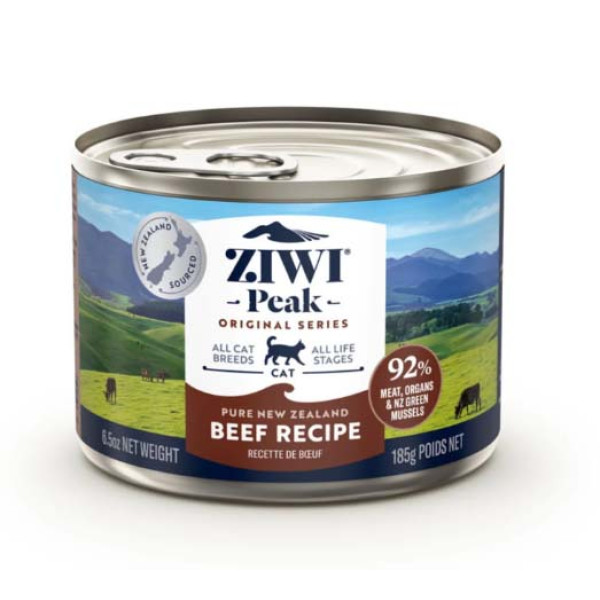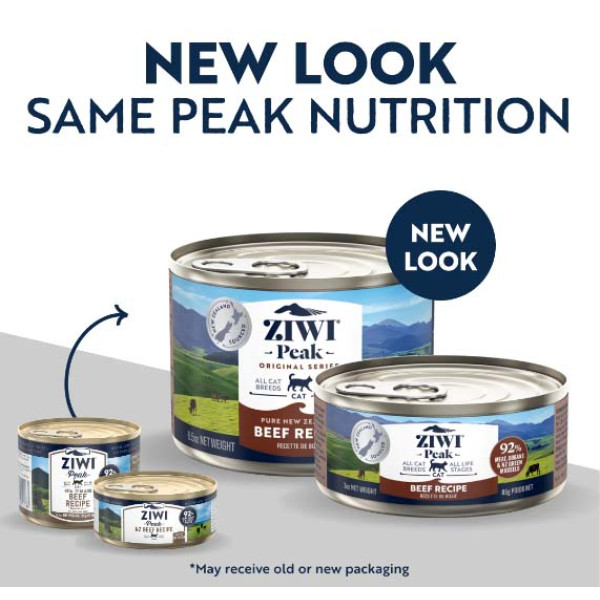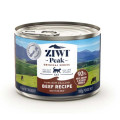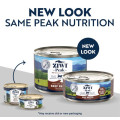數量
| 分享至 |
|
| 關鍵字 | Ziwi Peak Original Wet Beef Recipe for Cats 牛肉貓罐頭 6.5oz X 12 罐 |
ZIWI® Peak Wet Beef Recipe for Cats
PEAK NUTRITION FOR ALL LIFE STAGES
Raised simply, with access to fresh grass 365 days a year, New Zealand grass-fed and free-range beef has a reputation of being the best in the world. Just as our beef is raised, our recipe is simple too. Few ingredients but full of flavor, the perfect choice for cats of all breeds and life stages.

MEAT, ORGANS & NZ GREEN MUSSELS

Free-Range Grass Fed Farming

NO ANTIBIOTICS OR GROWTH PROMOTANTS

NO GRAINS POTATOES OR TAPIOCA STARCH

NO TSPP GUMS OR CARRAGEENAN

3% New Zealand Green Mussels
Ingredients
MEAT, ORGANS & NZ GREEN MUSSELS
Ingredients
Beef, Water Sufficient for Processing, Beef Lung, Beef Kidney, Beef Tripe, Beef Liver, Chickpeas, New Zealand Green Mussel, Beef Bone, DL-Methionine, Dried Kelp, Minerals (Magnesium Sulfate, Zinc Amino Acid Complex, Manganese Amino Acid Complex, Copper Amino Acid Complex), Taurine, Vitamins (Vitamin E Supplement, Thiamine Mononitrate, Pyridoxine Hydrochloride, Vitamin D3 Supplement, Folic Acid).
Guaranteed Analysis
Nutrient
Unit of Measure
Crude Protein
min. 9%
Crude Fat
min. 5.5%
Crude Fibre
max. 2%
Moisture
max. 78%
Ash
max. 4%
Chondroitin Sulfate (min)
300mg/kg
Calorie Content (calculated)
1250 kcal ME/kg | 231 kcal ME/185g can | 106 kcal ME/85g can
ZIWI® Peak Beef Recipe meets the nutritional levels established by the AAFCO Cat Food Nutrient Profiles for All Life Stages
Typical Analysis
Nutrients
As Received
Unit of Measure
Protein
11%
Fat
7%
Fibre
1%
Moisture
75.5%
Ash
2.0%
Carbohydrates
4%
Calories
1250
mg/kg
Calories
567
mg/kg
Chondroitin Sulphate
350
mg/kg
Minerals
Calcium
0.48%
Phosphorus
0.35%
Ca:P Ratio
1.36
Potassium
0.22%
Sodium
0.09%
Chloride
0.13%
Magnesium
0.03%
mg/kg
Iron
64
mg/kg
Copper
3.7
mg/kg
Manganese
3.5
mg/kg
Zinc
35
mg/kg
Iodine
1.80
mg/kg
Vitamins
Selenium
0.20
IU/kg
Vitamin A
33192
IU/kg
Vitamin D
540
IU/kg
Vitamin E
16
mg/kg
Thiamine (B1)
6.5
mg/kg
Riboflavin (B2)
3.0
mg/kg
Pantothenic acid (B5)
5.7
mg/kg
Niacin (B3)
33
mg/kg
Pyridoxine (B6)
6.8
mg/kg
Folic acid (B9)
0.45
mg/kg
Biotin (B7)
0.11
mg/kg
Vitamin B12
0.07
mg/kg
Amino Acids
Choline
827
Arginine
0.83%
Histidine
0.33%
Isoleucine
0.50%
Leucine
0.99%
Lysine
0.92%
Methionine
0.48%
Phenylalanine
0.54%
Threonine
0.52%
Tryptophan
0.15%
Valine
0.68%
Cystine
0.26%
Tyrosine
0.41%
Taurine
0.13%
Fatty Acids
Omega-3 fatty acid
0.18%
EPA
0.03%
DHA
0.02%
Omega-6 fatty acid
0.40%
Linoleic acid
0.31%
Arachidonic acid
0.09%
Transitioning your Cat to Ziwi Peak In the ideal world your cat would know they’re an obligate carnivore and that thehealthiest diet possiblefor themwas Ziwi Peak, which in turn would make your life aloteasier. The reality is many cats canbe quite resistant to a change in diet and it may take several weeks or longer to make the transition to a healthier diet like ours –so be persistentand eventually you will outwit your cat!Further down the track when your cat is basking in good health and vitality it will thank you for switching to a high meat and filler free diet that matches its digestive system.Time,patience, and some tricks are often required while transitioning your cat to a new food.Themost important thingis actually making the change,not how fast you accomplish it.Some cats are really easy, others are more challenging and take time and patience, and others are extremely challenging–see over pagefor transitioning tipsfor extra fussy cats.It does not mean that your cat does not like ZiwiPeak if it walks away from it for a few days, as cats are normally very suspicious of any change to their food. Keep in mind that cats tend to prefer a moist canned food, as they have a low thirst drive and derive most of their daily moisture from their food. Calculate how much to feed your cat by going to our Feeding Calculator at the top of our homepagewww.ziwipets.com.Remember that our feeding guide is a basic guideline, as all cats are so different. Therefore we recommend you monitor your cat’s condition and adjust the feeding amount if necessary.Introduce ZiwiPeak over a seven day period a little at a time mixed in with the cat’s existing food. Oneday one start by adding 15% Ziwi Peak and increase by 15% each day to the recommended daily amount over the seven days. You will need to reduce the amount being fedof the existing food each day to allow for the introduction of the Ziwi Peak food.Keep in mind that our Air dried food is extremely nutrient dense so you will be serving considerably less than you would with our Canned foodor with many other pet foods. The reason for this is our Air dried food contains no fillers and has had the majority of the moisture removed therefore 1kg is equivalent to 3kg raw meat.For smaller cats we recommend you weigh the Air dried food as overfeeding or underfeeding by 10gramsfor a 2kg cat can result in a big overfeed or underfeed as they eat so little. Ifyou want to feed a mixture of Canned and Air dried food first introduce ourCanned food,andthen adda littleAir dried food each day after the transition period. Just workout the feeding amounton our feeding calculator for each food type and reduce the feeding amount by half if you wish to feed a 50:50 mix of the Canned and Air dried food.Bring to room temperature-Make sure that any refrigerated Canned food is brought to room temperature by removing Canned food from the fridge 30 minutes before serving -cats prefer their food at 'mouse body’ temperature.Keep in mind that you don’t need to add any water to our Air dried product, as it already typically contains9% moisture so can be fed straight from the pouch. Your cat should also have access to plenty of clean fresh water. Cats don’t drink a lot of water however it aids your cat’s metabolic function. Remember to always reseal the Air-dried pouch after each use and store in a cool dry place away from sunlight. Moist canned food must be stored refrigerated once opened and should be used within 7 days.Your cat mayexperience softer stools during the transitionwhich is completely normal as the flora in the gut adjusts to the raw diet.If your cat gets diarrhoeadon’t abandon the transition, just slow the transition down and do it over a period of several weeks. Diarrhoea is usually a sign that the transition is too fast or you are overfeeding.It is not uncommon for some cats toregurgitateor vomita new food when trying it for the first time, especiallyifthey eat too muchtoo soon or eat too muchin one sitting. Don’t be concerned, this is quite normal for a cat to regurgitate or vomit a new food.If you are changing from a more processed food that contains more fillers to Ziwi Peakkeep in mind that Ziwi Peak is a lot more concentrated and nutrient dense than many other pet foods because it doesn’t contain any fillers. Therefore it is equivalent to feeding raw meat. If this happens werecommend you slow down the transition to give the gut some time to adjust to the new diet.Tips For Transitioning Extra Fussy CatsIf you have an extra fussy cat don’t lose hope! There’s hope around the corner in the form of seeing your much loved furry friend being the healthiest and most vibrant version of themselves that they can be! Imagine your cat at its bright eyed bushy tailed best basking in health and well being, and eventually beingthankful for your efforts to feed it the best food available! FreeFeeding-If you are free feeding your cat try implementing a feeding schedule by feeding 2-3 timesper day. Leave the food down for 30 minutes, and then remove any uneaten food. Repeat in 8 -12hours depending on if you are feeding 2 or 3 times per day. Leaving the food out all day encourages continual grazing as the animal is never hungry, so the digestive enzymes are never functioning correctly. It is natural for a cat in the wild to have an empty stomach as the digestive system is at its optimum to receive food. Try exercising your cat with a tassel toy before feeding. This can helptostimulatetheir appetite.Play with your cat–Throw one or two pieces of the air dried foodacross the room so that your cat canrun back and forth and ‘hunt’ for it.Pet your cat while he is in front of the food bowl. Some cats will be stimulated to eat when being petted.Sprinkle a very small amount of tuna, cooked chicken,or your catsfavourite treat on top of the canned food. Once they are eating it, start pressing it into the top of the new food.Bring food toroom temperature-Make sure that any refrigerated canned food is brought to room temperature by removing the canfrom the fridge 30 minutes before serving -cats prefer their food at 'mousebody’ temperature.Sprinklea little parmesan cheese on the canned food. Most cats love parmesan cheese and thistrick can be successful for some cats.'Chip and dip' trick–try dipping some air dried pieces in the canned food-put it onaseparateplate from a small portion of air dried food. Sprinkle crushed air driedfoodon the top of the canned food.If transitioning from dry kibble to canned food-try offering some cooked or rawchicken, meat,or deli-meat. This canget your cat used to eating food that does notcrunch, and get will also getused to a different food texture.Try addinga few small pieces of the canned food to a portion of your old kibblefood. Your cat may pick around the canned foodbut will get used to the smelland texture -even if he does noteat any pieces of the new food in the first few days





